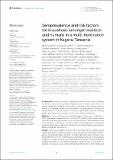| dc.description.abstract | Background: Brucellosis remains a significant health and economic challenge for livestock and humans globally. Despite its public health implications, the factors driving the endemic persistence of Brucella at the human-livestock interface in Tanzania remain poorly elucidated. This study aimed to identify the seroprevalence of Brucella infection in livestock and humans within a ranching system and determine associated risk factors for disease endemicity.
Methods: A cross-sectional sero-epidemiological study was conducted in 2023 in Tanzania’s Karagwe District, involving 725 livestock (cattle, goats, sheep) from 10 herds and 112 humans from associated camps. Seroprevalence was assessed using competitive ELISA while epidemiological data were collected via questionnaires. Generalized Linear Models and Contrast Analysis were used to identify risk factors for infection.
Results: Overall seroprevalence was 34% in livestock and 41% in humans. Goats exhibited the highest prevalence (69.2%), while cattle had the lowest (22.6%). Mixed-species herds (Odds Ratio, OR = 2.96, CI [1.90–4.60]) and small ruminants-only herds (OR = 6.54, CI [3.65–11.72]) showed a significantly higher risk of seropositivity compared to cattle-only herds. Older cattle (OR = 5.23, CI [2.70–10.10]) and lactating females (OR = 2.87, CI [1.78–4.63]) represented significant risks for brucellosis in livestock. In humans, close contact with animals (OR = 7.20, CI [1.97–36.31]) and handling animals during parturition or aborted fetuses (OR = 2.37, CI [1.01–5.58]) were significant risk factors. Notably, no spatial association was found in seroprevalence between herds and nearby human communities.
Conclusion: The lack of spatial correlation between livestock and human seroprevalence suggests complex transmission dynamics, potentially involving endemic circulation in livestock and human infections from multiple sources of exposure to livestock. This study highlights the need for comprehensive zoonotic risk education and targeted intervention strategies. Further research is crucial to elucidate transmission pathways and improve Brucella infection control. This includes developing robust methods for identifying infective species and implementing effective strategies to mitigate Brucella infection in endemic regions. | en_US |

